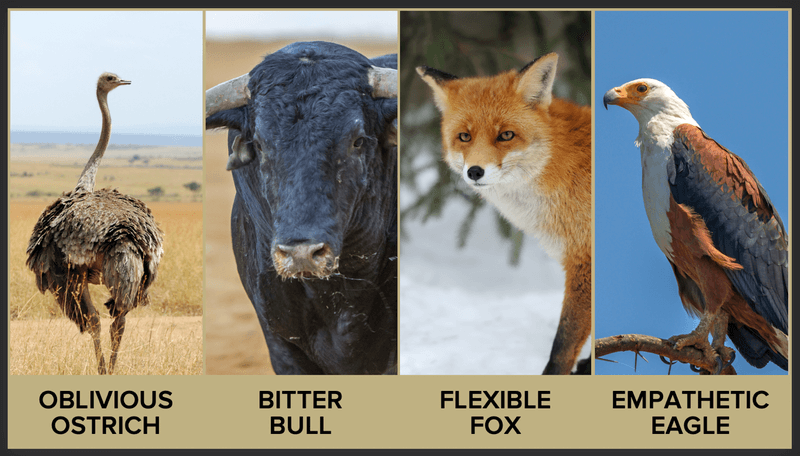The four types of leaders that will emerge during tough times
“It is your reaction to adversity, not the adversity itself, that determines how your life's story will develop.”
Dieter F. Uchtdorf
When pressure builds up, human behaviour will change.
That is something you probably have noticed over the last couple of months. 2020 for most, has been a roller-coaster ride with no end, but unlike most amusement parks, we do not get to see how the journey will be. We cannot anticipate the twists and turns, ups and downs. We can only shift our body weight as we are thrown at each turn, and balance it out as we exit, while waiting anxiously for the next jolt.
And in this state of rising and constant pressure, we also realised that just like us, the behaviours of those around us have shifted as well. While technology and digitalisation are the key areas of focus, how these changes are being adopted in different organisations will largely depend on the leaders themselves.
Interestingly, when it comes to behaviours, we often gain most insights when we detach ourselves from the situation, and borrow inspiration from Mother Nature.
Do understand that the article is, by no means, to compare the readers to animals.

A leader is someone who you’d want to follow in times of crisis
The Oblivious Ostrich
Even after the Coronavirus has hit a global pandemic scale, causing economic conditions to come to a standstill in certain parts of the world, there are still some leaders who made a conscious decision to just stay in denial and say “this too, shall pass”.
Despite seeing more and more customers and consumers going online and adopting new digital habits, the Oblivious Ostrich leaders tend to just brush it off as a "hype that won’t last”. Citing there will always be a market segment who are less tech-savvy that needs to be served, they choose to not make any drastic pivot plans.
Often misinterpreted as optimism, such behaviours of denial (and ignorance!) can spell disaster even during the good times. Companies like Kodak and Nokia are just some examples we can all learn from.
What to do when you are working with an Oblivious Ostrich?
Have a plan B that is ready to be implemented the moment he or she changes her mind. Because it is hard to convince them on a personal level; leverage instead on reports and white papers from sources they trust.
The Bitter Bull
While it is good that these leaders are acknowledging the situation, they are reacting instead of responding. Emotions are high, and rash decisions are prone to be made. In a mixed mental state of desperation, anxiety, and panic, they would often start lashing out at others as well, blaming external forces they have no control over.
As they make a string of bad decisions and while the costly mistakes pile up, they will be pushed further into the corner, and in the heat of the moment, may just snap and start destroying everything they have built. Teams become collateral damage, while bridges are burned and connections severed.
What to do if you are working with a Bitter Bull?
Try to empathise that their resourcefulness is tied to the environment in which they operate in, and if harsh words were thrown around, do not take them to heart. Give them space to clear their mind, even if you will need to force them to face reality. Assure them the business will still be around after their short time-off, and trust that in the process of recalibrating their emotions, they will gain clarity and act with wisdom.
The Flexible Fox
Agility is the middle name, and in times of crisis, these leaders spring into action. While it is good that they are on the move; the danger is, without knowing, they may be moving in a less favourable direction.
These are the masters of pivots, and the direction of the ship can change several times during its course. While thoughts and ideas are fast to form, execution and results will take time, even for the most agile of organisations.
Combine the impatience and the lack of foresight, the Flexible Foxes may not allow the idea and execution to gestate and expect results to happen in an instant. This may also cause the team to drop the ball due the heightened pace, while others are left in the dust.
What to do if you are working with a Flexible Fox?
While nobody likes to be the kite that’s being held back by the string, it is important to let the Flexible Foxes know what are the key performance indicators or business metrics that will be positively impacted with their ideas. The timeline and expectations must also be communicated as well, and constant communication will ensure that all team members are on the same page.
In their flurry of ideas that are waiting to be executed, I would recommend a technique that I learned from fast-paced start-ups:
- Pin all the ideas up on the wall and pitch them to everyone in the room.
- Every team member (the leaders included) is given 2-3 coloured stickers to vote on which idea is the best.
- The idea with the most votes gets executed first, of course with the KPIs well-communicated upfront.
The Empathetic Eagle
“You’ll never see a wise person run.” That is a lesson I learned while I was on the community of mentors in the start-up scene.
While the Flexible Foxes are the action takers, the Empathetic Eagles are the true visionaries. Despite the incoming storm and darkened path, they rise above the clouds and see far and wide.
It is common to assume all leaders have the gift of vision and therefore, see further than anyone else. However, only the wisest are able to see at a high level, and still come down to the ground level to communicate with the team. Seeing the path is one thing; guiding the team on the path when even the next steps may not be clear? Now, that takes skill and wisdom!
How can you become an Empathetic Eagle?
To stay calm even though everything you have built seems to be breaking down. You will first need to disassociate yourself from the situation. In the state of confusion and anxiousness, you will realise that you have lots of ideas to explore. Bear in mind that in this state of economy, you cannot afford to take one step forward and four steps back.
Be open to borrowing ideas from other industries and simplify your message so that your team and business partners are clear on what needs to be done. As you are breaking apart the old systems to do things, take the opportunity to incorporate technology and digitalisation.
The Best of Both Worlds
While many may think that the Empathetic Eagle is something all leaders should strive for in this current crisis, the truth is, the best leaders are a combination of the Empathetic Eagle and the Flexible Fox. The key is knowing which role to play in the shifting of the tides, and emerge as the market leader in this brave, new world.

This is a contribution by Dato’ James Foo, Founder of 80+ Startups in 13 industries and 4 IPOs.


